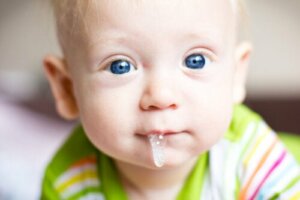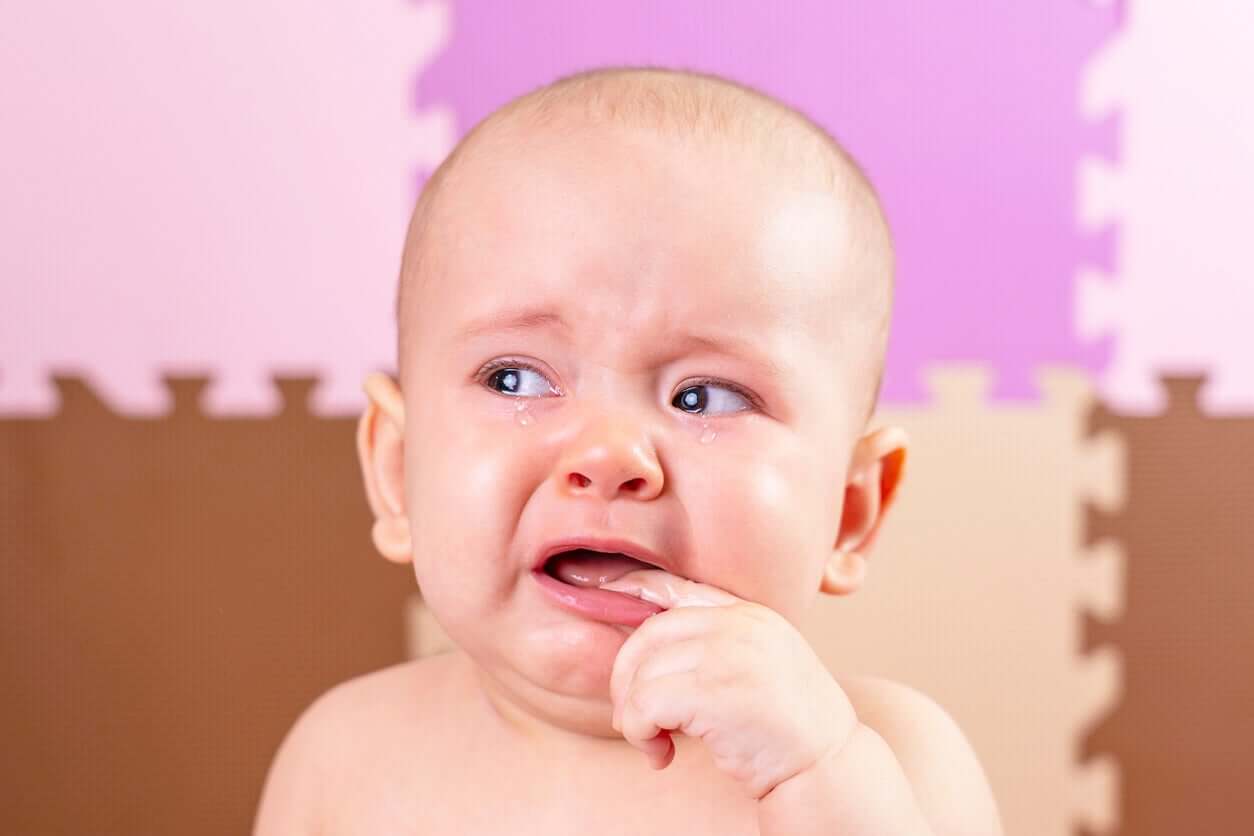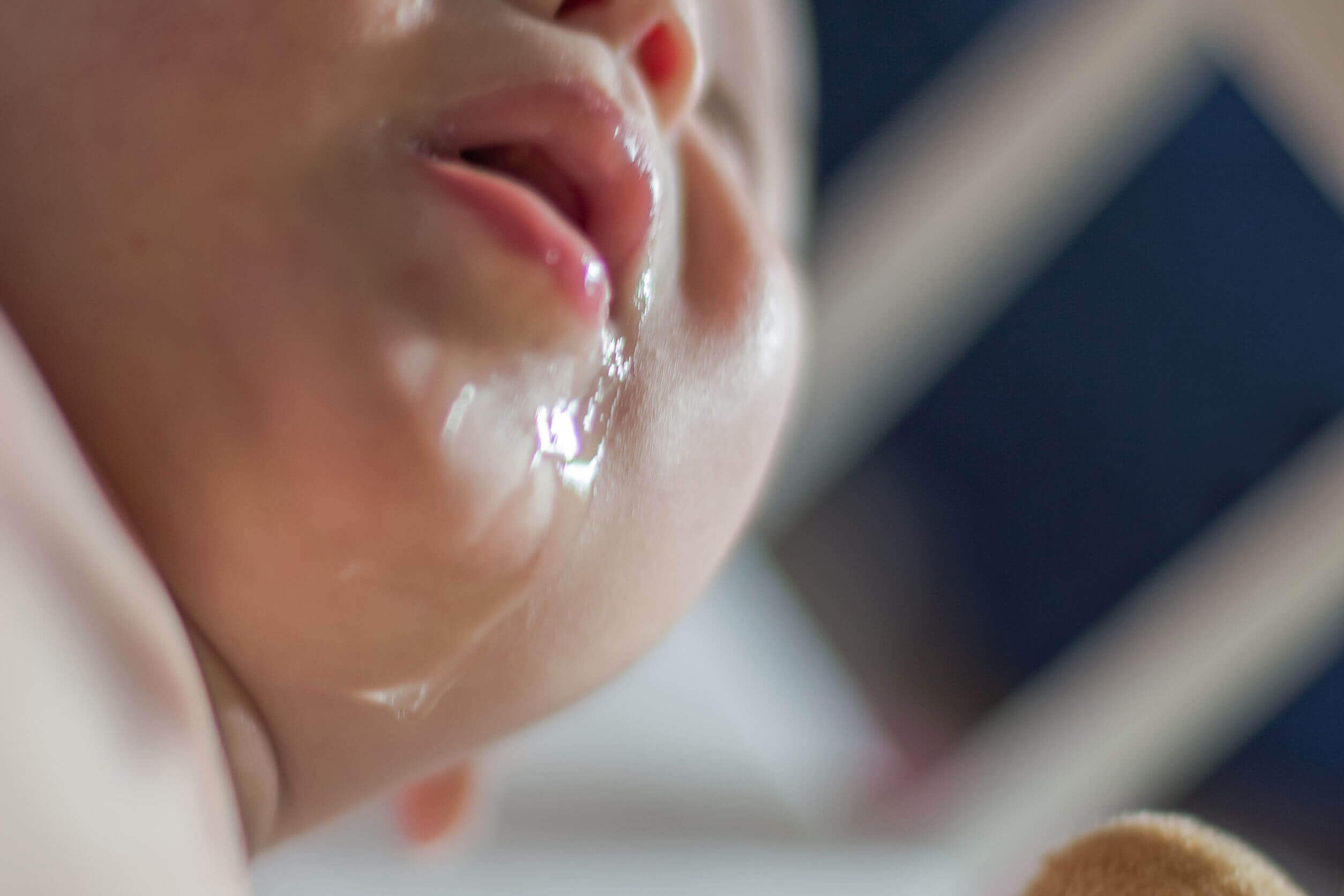Excess Drooling in Babies: When to Worry?

If you feel like bibs and washcloths are no longer enough when it comes to drying up so much saliva, you may be wondering if excess drooling in your baby is normal. But is it really necessary to worry about how much liquid keeps coming out of your child’s mouth?
Here, we’re going to tell you everything you need to know about saliva production in babies so that you’re clear about how long this stage lasts and when you need to do something about it. Don’t miss it!
Why do babies drool?
Drooling isn’t usually a problem at birth, as newborn babies secrete very little saliva. But as time passes, the development of the salivary glands causes more fluid production in the mouth.
Excess drooling in babies usually begins between 2 and 4 months, a period in which the salivary glands begin to function fully. Most responsible for the abundance of drooling is the development of the parotids, two large glands located on each side of the face, below the ears.
The explanation for this phenomenon is simple: The increased production of the liquid and the lack of ability to swallow it in its entirety causes excess saliva to end up coming out of the mouth. In most cases, it’s expelled through the corners of the lips and then it gets on the child’s face, neck, clothing, or bibs.
You may wonder why the child isn’t able to swallow saliva but is able to swallow milk when feeding. Well, in the latter case, the swallowing reflex is triggered due to the effort of the muscles of the mouth during suction.
But this automatic response isn’t activated by saliva produced in the oral cavity, as it’s secreted involuntarily. For this reason, it accumulates in the mouth until it exceeds the capacity and comes out. As time passes, the automatic swallowing reflex fully develops and drooling is greatly reduced.
Common explanations of excess drooling in the baby

Many times, excess drooling in babies has to do with the teething process, but this isn’t always the case. In fact, they’re independent phenomena that can sometimes coincide.
Tooth eruption usually begins a few months after the development of the salivary glands, around the sixth month. At this stage, saliva can help reduce the discomfort caused by tooth eruption, and also, the need for little ones to put everything in their mouths can make drooling more noticeable.
Another event that’s often related to excess saliva in the baby is the incorporation of their first foods, as new flavors on the taste buds stimulate the salivary glands. And the secretion that they produce is very necessary for the process of chewing and swallowing food.
When to worry about excess drooling in babies
Excess drooling in babies is considered normal for 2 years, although the times of each child are different and can persist up to 3 years. As we explained before, the automatic swallowing reflex develops little by little and this is what allows you to control your salivary production.
In turn, within this period of time, there are certain circumstances that cause an increase in the excretion of drool and they are as follows:
- Teething
- Exploring the hands and objects with the mouth
- Infectious symptoms of the respiratory tract (such as colds or herpangina)
- Oral thrush
- The incorporation of new foods into the diet
- Some allergies
These situations are temporary and are considered normal, but if the excessive production of saliva continues for a long time beyond what’s expected, you’ll need to consult the pediatrician. Likewise, if it reappears suddenly after having disappeared or if it manifests itself in older children.
Some nervous system conditions are associated with the inability to swallow saliva or increased saliva production (hypersalivation). For this reason, it’s important to request a consultation when this symptom is accompanied by other manifestations, such as those mentioned below:
- Difficulty breathing
- Regurgitation of food
- Trouble holding their head up
- Mouth breathing or the habit of always keeping the mouth open
- Fever
- Strange odor or color in the saliva
How to treat excess drooling in babies?
Excess drooling in babies is usually a normal situation that doesn’t require any treatment. You just have to wait for the little one to grow up and develop the skills to swallow the saliva they produce.
In any case, you can accompany your child so they go through this stage with greater comfort. For example, putting on a bib and changing it frequently so that the clothing underneath doesn’t get wet and their skin doesn’t get damp. In the long run, this can lead to skin irritations and predispose babies to the development of yeast infections.
When a child begins to incorporate solid foods, it’s very important to motivate them to chew and swallow. This is because exercising the muscles and increasing the sensitivity of the mouth are good stimuli in order to master the ability to swallow. Offering foods with different textures, flavors, and temperatures facilitates this learning.

About excessive drooling, we can say…
Every child is different and there are some who drool more than others. In general, and if it’s not prolonged in time, excessive drooling in babies shouldn’t be a cause for concern. It’s a part of the maturation process of the first year of life. Just the same, if you have any concerns about this stage or you fear that something isn’t going well with your little one, the best idea is to go to the pediatrician.
If you feel like bibs and washcloths are no longer enough when it comes to drying up so much saliva, you may be wondering if excess drooling in your baby is normal. But is it really necessary to worry about how much liquid keeps coming out of your child’s mouth?
Here, we’re going to tell you everything you need to know about saliva production in babies so that you’re clear about how long this stage lasts and when you need to do something about it. Don’t miss it!
Why do babies drool?
Drooling isn’t usually a problem at birth, as newborn babies secrete very little saliva. But as time passes, the development of the salivary glands causes more fluid production in the mouth.
Excess drooling in babies usually begins between 2 and 4 months, a period in which the salivary glands begin to function fully. Most responsible for the abundance of drooling is the development of the parotids, two large glands located on each side of the face, below the ears.
The explanation for this phenomenon is simple: The increased production of the liquid and the lack of ability to swallow it in its entirety causes excess saliva to end up coming out of the mouth. In most cases, it’s expelled through the corners of the lips and then it gets on the child’s face, neck, clothing, or bibs.
You may wonder why the child isn’t able to swallow saliva but is able to swallow milk when feeding. Well, in the latter case, the swallowing reflex is triggered due to the effort of the muscles of the mouth during suction.
But this automatic response isn’t activated by saliva produced in the oral cavity, as it’s secreted involuntarily. For this reason, it accumulates in the mouth until it exceeds the capacity and comes out. As time passes, the automatic swallowing reflex fully develops and drooling is greatly reduced.
Common explanations of excess drooling in the baby

Many times, excess drooling in babies has to do with the teething process, but this isn’t always the case. In fact, they’re independent phenomena that can sometimes coincide.
Tooth eruption usually begins a few months after the development of the salivary glands, around the sixth month. At this stage, saliva can help reduce the discomfort caused by tooth eruption, and also, the need for little ones to put everything in their mouths can make drooling more noticeable.
Another event that’s often related to excess saliva in the baby is the incorporation of their first foods, as new flavors on the taste buds stimulate the salivary glands. And the secretion that they produce is very necessary for the process of chewing and swallowing food.
When to worry about excess drooling in babies
Excess drooling in babies is considered normal for 2 years, although the times of each child are different and can persist up to 3 years. As we explained before, the automatic swallowing reflex develops little by little and this is what allows you to control your salivary production.
In turn, within this period of time, there are certain circumstances that cause an increase in the excretion of drool and they are as follows:
- Teething
- Exploring the hands and objects with the mouth
- Infectious symptoms of the respiratory tract (such as colds or herpangina)
- Oral thrush
- The incorporation of new foods into the diet
- Some allergies
These situations are temporary and are considered normal, but if the excessive production of saliva continues for a long time beyond what’s expected, you’ll need to consult the pediatrician. Likewise, if it reappears suddenly after having disappeared or if it manifests itself in older children.
Some nervous system conditions are associated with the inability to swallow saliva or increased saliva production (hypersalivation). For this reason, it’s important to request a consultation when this symptom is accompanied by other manifestations, such as those mentioned below:
- Difficulty breathing
- Regurgitation of food
- Trouble holding their head up
- Mouth breathing or the habit of always keeping the mouth open
- Fever
- Strange odor or color in the saliva
How to treat excess drooling in babies?
Excess drooling in babies is usually a normal situation that doesn’t require any treatment. You just have to wait for the little one to grow up and develop the skills to swallow the saliva they produce.
In any case, you can accompany your child so they go through this stage with greater comfort. For example, putting on a bib and changing it frequently so that the clothing underneath doesn’t get wet and their skin doesn’t get damp. In the long run, this can lead to skin irritations and predispose babies to the development of yeast infections.
When a child begins to incorporate solid foods, it’s very important to motivate them to chew and swallow. This is because exercising the muscles and increasing the sensitivity of the mouth are good stimuli in order to master the ability to swallow. Offering foods with different textures, flavors, and temperatures facilitates this learning.

About excessive drooling, we can say…
Every child is different and there are some who drool more than others. In general, and if it’s not prolonged in time, excessive drooling in babies shouldn’t be a cause for concern. It’s a part of the maturation process of the first year of life. Just the same, if you have any concerns about this stage or you fear that something isn’t going well with your little one, the best idea is to go to the pediatrician.
All cited sources were thoroughly reviewed by our team to ensure their quality, reliability, currency, and validity. The bibliography of this article was considered reliable and of academic or scientific accuracy.
- Héctor, E. M. L. H. D., & Carriera, G. G. P. R. S. MANEJO CLINICO Y FARMACOLÓGICO EN PACIENTE CON SIALORREA: REPORTE DE CASO.
- Reinoso, D. R., & Mujica, H. S. Tratamiento de la sialorrea con toxina botulinica en niños con paralisis cerebral.
- Savigñón, M. S., Santana, N. T. M., Pérez, N. P., & Agüero, E. G. (2020). Intervención logopédica para el control de la sialorrea en niños con parálisis cerebral. Revista Cubana de Medicina Física y Rehabilitación, 12(3).
- Vílchez-Barrera, M., & Lozano-Céspedes, D. (2019). Efectos del kinesiotaping en el control de la sialorrea en niños con patologías del sistema nervioso central: revisión sistemática. Rev. neurol.(Ed. impr.), 353-362.
- Jiménez, S. G. (2017). Cuidados del bebé. El farmacéutico: profesión y cultura, (550), 22-30.
- Tamayo, T. G., Pulido, R. T. R. B., & Velasco, I. A. N. Capítulo 13. Amor a flor de piel. Alimento esencial para tu bebé: sus primeros masajes. Disponible en: https://www.cucs.udg.mx/libros/bebe290921.pdf#page=91
- Alcaide Baena, C. (2021). Evaluación y tratamiento de sialorrea en pacientes neurológicos pediátricos.
- Gijón Cano, I. (2019). Efectividad del tratamiento orofacial en los trastornos oclusivos de niños con Síndrome de Down.
- Barembaum, S., & Azcurra, A. La saliva: una potencial herramienta en la Odontología. Revista de la Facultad de Odontología, 29(2), 9-21.
- De Rossi, A., Nelson-Filho, P., De Rossi, M., Huamán, S. D., & Vilela, M. M. (2020). Odontología para bebés: una posibilidad práctica de promoción de salud bucal. Revista de Odontopediatría Latinoamericana, 7(2), 116-126.
This text is provided for informational purposes only and does not replace consultation with a professional. If in doubt, consult your specialist.








